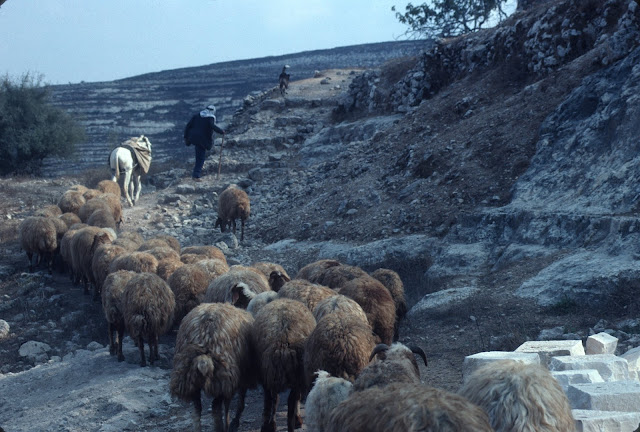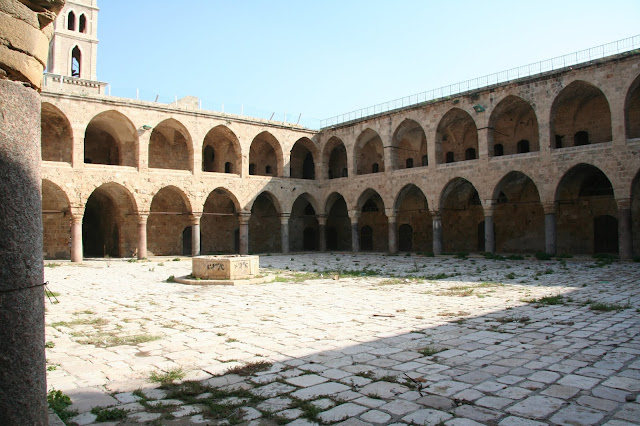
Church of the Nativity and Manger Square, 1989.

Manger Square, 1989

The journey of Mary and Joseph to Bethlehem from Nazareth to pay Roman taxes could have followed one of three routes. The coastal route, the shortest route through Samaria or the most likely route down the Jordan River Valley to Jericho and then up to Jerusalem.
A group of BYU students walking the rocky hills of Samaria in 1982. This is one route the holy family could have taken to Jerusalem, but it meant going through rival Samaria.

The route from Jericho up to Jerusalem passed through the arid Judean wilderness.
The three towers on the distant hill are on the crest of the Mt of Olives. From the midst of the Judean Wilderness.
1982 view of Bethlehem to the southeast from kibbutz Ramat Rachel--southernmost Jerusalem.
View southward to Bethlehem (upper portion) and Beit Sahour (lower portion) from Shepherd's Field.
A Caravanseri in Edirne Turkey. Historically these buildings are where caravans would stop in cities. The goods they carried, plus any animals they brought were stored in the lower rooms, while the travelers slept up on the second level. Some suggest that "Inns" at the time of Jesus were similar in structure. There may have been no room for Mary and Joseph to sleep up above and so the Holy Family found lodging down below with the animals.
A Caravanseri in Akko (Acre) Israel.

he Church of the Nativity In Bethlehem (Steeples from l to r) Roman Catholic, Armenian, Greek Orthodox.



Short door to keep horsemen riding in.

This is the longest standing Church in the Holy Land--it being the only church not destroyed by the invading Persians in 614. It is built in a traditional Byzantine basilica style.
Long lines of tourist waiting to go down into the grotto of the nativity.
For an in depth look at the impressive and beautiful restoration of the Basilica of the Nativity during the past nine years please check out this link. Those who visited the church before 2011will be surprised. Watch this video: http://www.nativityrestoration.ps/presentation


Beneath this Greek Orthodox altar is a grotto where tradition has it Jesus was born.

The 16 pointed star marks the spot. Its removal by competing Catholics and Orthodox helped cause the Crimean War.

The place where baby Jesus laid in a manger.

An adjacent grotto is where Jerome translated the Bible. Grottoes like this beneath or behind homes were also used to stable animals.
Here is a link to an interesting article about the realities of what the "stable" may really have been:
https://www.psephizo.com/biblical-studies/once-more-jesus-was-not-born-in-a-stable/?fbclid=IwAR3wEMh3phQJAG5ohE_7l785yqbqB_4tOh4F1T582jfkwuUGr2lzXcbnp7A
Catholic Church of St. Catherine adjacent to the Basilica of the Nativity.


The roof of the Church of the Nativity leaked for years, but the three competing and jointly controlling powers could not agree on who should repair it. The Roman Catholics had the money to do it, but the Armenians and Greeks Orthodox felt that if the Catholics paid to fix it they would then claim control of everything underneath it. This roof has recently been replaced with a lead sheet roof.

The view of Bethlehem with its many steeples and minarets from atop the Greek Orthodox Steeple.
Palestinian shepherd leading his flock near Gibeon (Jib) 1989.

Shepherd and sheep in the Judean wilderness after some winter rains. Notice all of the sheep tracks along the hill side.
Palestinian Shepherdess at the one time Jerusalem Sheep market out side the wall near the Pool of Bethesda. 1979.

Mexican nativity with two shepherdesses.

BYU Summer 2010 Jerusalem students invited the Emmett family to participate in the nativity play as the sheep--including one black sheep.


Mormons love to come to this valley to the northwest of Beit Sahour to remember that first Christmas night. The flat top of the Herodium in the distance.

Winter Semester 2010 BYU Jerusalem Center Students gather in March for a Christmas Program. Bethlehem is in the distance. The route of the separation wall/barrier/fence cuts across the middle of distant hillside.
Travelers on a LDS cruise and the BYU students gather in "Mormon Shepherd's Field" in 1982. Special guest is Elder Howard W. Hunter--seated at right.
No one knows where the shepherds were when the angels visited, so there are many options: Orthodox, Catholic and Protestant plus Mormons who like to find their own fields. Me in a 1982 photo.
Catholic Chapel at Shepherd's field.
Christian-Arab-Palestinian town of Beit Sahour with the Greek Orthodox Church of Shepherd's Field.

The Herodian to the south east of Bethlehem. Herod may have been staying is this one of his many palaces on the night the angels visited the shepherds. They didn't herald the King, they heralded the shepherds (who may have been Levite shepherds taking care of the sheep destined for sacrifice in the temple). Such irony that the mighty king missed the announcement.

The ruins of Herod's hill top fortress.
Looking west towards Bethlehem on the distant hills.
Bethlehem straight ahead on the distant hills and Shepherd's Fields to the right. The Wise Men may later have visited Herod in the Herodium.

The Temple Mount (also called the Nobel Sanctuary by Muslims)
The temple where Jesus was greeted by Simeon and Anna.
The Holy Family would most likely have entered the temple mount via the double and triple gates on the south side (beneath the long red roof).

The Roman era stairs leading up to those arched entries.

Triple gates from the time of Jesus.

Part of the the Cardo (main shopping street of the Roman town) on the south west perimeter of the temple mount.. The shops to the left could have been where Joseph and Mary purchased the turtledoves or pigeons for an offering.

Jewish family in front of the ancient shops.
The shortest travel-able route from the east (perhaps Persia) to
Bethlehem was across the Syrian desert with a stop for water at the
oasis of Palmyra/Tadmor (located by the R in Syria on the map)

The roman ruins of the bustling oasis located along the ancient caravan route between Persia and Palestine. Sadly many of its ruins were destroyed by ISIS.

Camels in the cardo of Palmyra.
Camels in the Sinai.
Frankincense tress in Oman.
Frankincense resin oozing from a tree in Oman.

Lovely painting of the visit of the Magi by my niece Emily Hurst Pritchett. Prints for sale at: https://emilypritchettart.com/

It is very unlikely that the visit of the wise men would have been to the same place the shepherd's visited. Still the Church of the Nativity is of interest to the wise men part of the story. Apparently the story is told that the Byzantine Church included a mosaic on the triangular shaped portion above the short entry just below the cross that depicted the wise men as Persians. When the Persians rampaged through the Byzantine controlled Holy Land they destroyed all of the churches on their way. Until they rode in to Bethlehem. There, the story goes, they looked up and saw their fellow countrymen--the magi. They could not bear to destroy them so they let the church stand.

Enterprising merchants in Bethlehem now sell these olive wood nativities where a wall keeps the wise men from visiting the Holy Family.
The Milk Grotto Church where tradition has it Mary spilled some milk just prior to their departure for Egypt.

Flight in to Egypt painted on papyrus.
Coptic Hanging Church in Cairo.
The holy family and the Nile River.
Joseph being told it is safe to return to Nazareth.
Beautiful interior of the church.
Images from Nazareth of the Holy Family
For more text and images related to the Nativity story see this previous blog post: http://beitemmett.blogspot.com/2014/12/the-setting-and-story-of-christmas.html





















































No comments:
Post a Comment